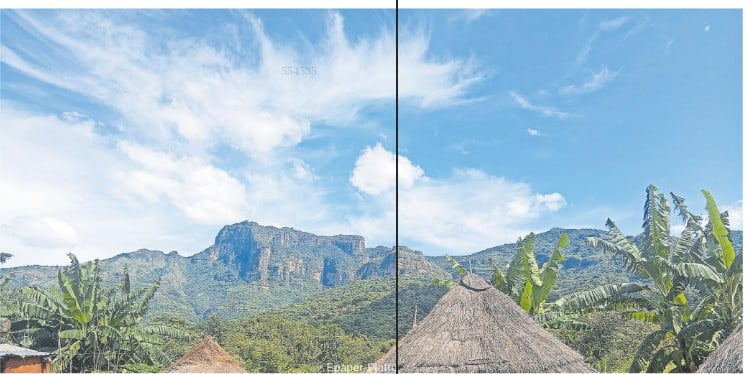Prime
Is that tree fit for your compound?

Before putting a tree in the compound, one has to think about the size of the compound. PHOTO/Kelvin Atuhaire
What you need to know:
An umbrella tree or one that bears fruit, there is a lot one has to consider before planting a compound tree.
Besides beautifying a home, trees offer a lot more. Trees provide a shed, fresh air and in some cases they are medicinal.
Years back, every compound had trees; whether fruit bearing or the native non fruit bearing trees, you would find at least a tree in your ancestral home; that old umbrella tree, mango tree, Muvule or Musizi in your granny’s compound.
Some still exist to date.
Limited by space, tree planting has become a luxury for many. Meanwhile those with ample space only opt for quick growing and fruit bearing trees for their compounds.
Choice of a tree
Ronald Kavuma, a florist and landscape designer in Seguku, says there are three major factors that influence choice of tree species for the compound; space, preference and surrounding features.
Preference refers to the comfort a homeowner gains from planting a tree. Some people want trees just to beautify and add a feeling of luxury to their compounds.
Any kind of tree can provide shed and fresh air, however, Kavuma says there are some specific tree species including the umbrella tree that do the job best.
Apart from interest, one must put into consideration the size of the other home features. Kavuma advises that trees should be distant from the house, electric wires and the sewerage system to avoid accidents.
“Branches can grow into electric wires, while roots can also go deep into sewerage pipes causing emergencies. We have also seen tree branches falling on houses and parked cars,” he says.
Majority home owners nowadays go for fruit bearing trees such as mangoes, guavas and jackfruit among others because they serve the family with nutritious fruits.
However, besides general interest in a particular tree, there are other things people must look out for while planting and maintaining them.
Beauty and purpose
The beauty of trees ranges from the leaf colour and flowers to the shape of branches and structure.
Peter Busulwa, a gardener in Makindye, Kizungu, says ornamental trees such as Albizia coriaria, also known as mugavu tree which put on white and pink flowers, an African Tulip with red flowers known locally as kifabakazi with red flowers, coconut trees among others are planted to beautify compounds.
“In compound design we look at beauty hence a need to plant ornamental trees that are good to look at,” Busulwa says.
He adds that trees attract wildlife such as birds and butterflies.
Meanwhile, Kavuma says medicinal and fruit bearing trees such as the neem tree, mangoes, oranges and avocado among others are important as they can serve people at home.
However, trees can also lead to infestations especially those with thick leaves and branches. These may harbour vectors and pests such as mosquitoes or even snakes that might be harmful to human beings.
“It is advisable to include plants such as lavender, jasmine that have repelling scents in their leaves to solve such a problem,” Kavuma says.
Likewise eucalyptus trees of all kinds including the broad-leaved eucalyptus, lemon-scented eucalyptus and narrow –leaved eucalyptus all repel vectors according to Kavuma.
Safety
Some trees such as the black locust and oleander have poisonous leaves and fruits that can be a threat to human health as well as pets at home.
“One should be cautious about such trees as well as others that emit funny odours at specific times,” Busulwa advises.
Trees like palms and umbrella trees that shed heavy branches are dangerous to have in the compound especially since the branches can damage property.
If not critically chosen, some of these trees may end up doing more harm than good.
Busulwa says trees whose roots grow from the soil surface such as the figs, some mango tree species among others should be avoided.
This is because water can be trapped by the roots causing flooding. They also render mowing difficult.
“Compound level is very important hence a need to plant trees whose roots will not affect it,” he advises.
Easy maintenance
Before planting a tree, you should look into the ease with which it can be maintained according to Kavuma.
“Some tree species are not drought resistant hence a need to be watered during the dry seasons or they could dry up,” he says.
Likewise, trees that frequently shed leaves make compound maintenance difficult thus, it would make sense to consider for instance avocado or guava trees that don’t shed leaves as much.
“Trees such as eucalyptus often drop big heavy resin-filled branches. Its bark peels off annually adding to seasonal maintenance tasks,” Busulwa says.
Saving space
Trees such as oaks and walnuts with tap roots that grow deeper into the soil are suitable unlike those with fibrous roots that can meander far away to cause damage to house features.
“Trees with fibrous roots should not be planted in a small compound because with time, the tree roots spread wide just like their canopies and end up causing root related difficulties to the home structures,” Busulwa says.
Pines, Musizi, Muvule and Mahogany, among other timber trees are not suitable for small compounds because they can grow into big uncontrollable sizes hence taking up too much space.
Tree enemies.
Termites are among the major threats to mature trees as they can eat up the roots and stems drying the tree.
Fungal diseases such as root rots, sap rot or even wilt can be dangerous to trees




